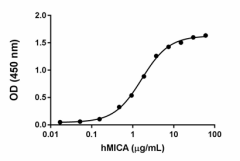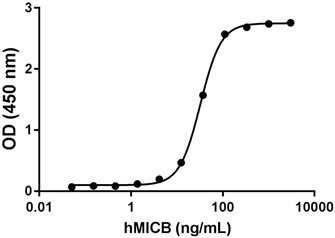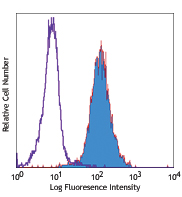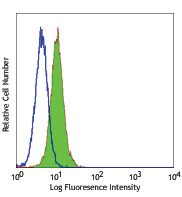- Regulatory Status
- RUO
- Other Names
- MHC class I polypeptide-related sequence A, Truncated MHC Class I Polypeptide-Related Sequence A, MHC Class I Chain-Related Protein A, Stress Inducible Class I Homolog, HLA Class I Antigen, PERB11.1, MIC-A
- Ave. Rating
- Submit a Review
- Product Citations
- publications

-

Recombinant human MICA binds to immobilized recombinant human NKG2D in a dose-dependent manner using a functional ELISA. The ED50 for this effect is 1 - 5 µg/mL. -

Stability Testing for Recombinant Human MICA. Recombinant human MICA was aliquoted in PBS, pH 7 at 0.2 mg/mL. One aliquot was frozen and thawed four times (4x Freeze/Thaws) and compared to the control that was kept at 4°C (control). The samples were tested for their ability to bind to immobilized NKG2D in a dose-dependent manner using a functional ELISA. The ED50 for this effect is 1 - 5 µg/mL.
MICA, human major histocompatibility complex (MHC) class I polypeptide-related sequence A is a member of the MIC family that includes MICA, MICB, and five pseudogenes MICC to MICG. MICA is a protein of 383 amino acids and interacts with the NKG2D receptor and the T cell receptor (TCR) to activate NK cells, αβ CD8 T cells, and γδ T cells. MICA and MICB contain two Ig-like domains (α1, α2) and the C-type Ig-like α3 domain, a transmembrane domain, and a carboxyl-terminal intracellular tail. MICA and MICB are conserved in most mammals, but not in rodents. MICA and MICB have high similarity (84% identical). MICA and MICB diverge from the MHC class I family, when they are compared domain by domain, they present a similarity of 28 to 35%. MICA and MICB bind to NKG2D, and the binding of MICB to the receptor can be blocked by a chimeric form of UL16; indicating that UL16 binds to the same, or overlaps with the binding epitope present in NKG2D on the NK cells. MICA and MICB, and the UL16-binding proteins are expressed in the membrane of tumor cells, and the participation of ADAM10 and ADAM17 has been associated to shedding of these NKG2D ligands. Soluble NKG2D ligands downregulate NKG2D expression in the effector lymphocytes; therefore, helping the tumor to escape.
Product DetailsProduct Details
- Source
- Human MICA, amino acid Glu24 - Trp308 (Accession # Q29983) was expressed in CHO cells. The carboxyl terminus contains SRIG-Fc 6His tag.
- Molecular Mass
- The 529 amino acid recombinant protein has a predicted molecular mass of approximately 62.6 kD. The DTT-reduced and non-reduced protein migrate at approximately 80 kD and 160 kD respectively by SDS-PAGE. The predicted N-terminal amino acid is Glu.
- Purity
- >95%, as determined by Coomassie stained SDS-PAGE.
- Formulation
- 0.22 µm filtered protein solution is in PBS pH 7.2.
- Endotoxin Level
- Less than 0.1 EU per µg protein as determined by the LAL method.
- Concentration
- 10 and 25 µg sizes are bottled at 200 µg/mL. 100 µg size and larger sizes are lot-specific and bottled at the concentration indicated on the vial. To obtain lot-specific concentration and expiration, please enter the lot number in our Certificate of Analysis online tool.
- Storage & Handling
- Unopened vial can be stored between 2°C and 8°C for up to 2 weeks, at -20°C for up to six months, or at -70°C or colder until the expiration date. For maximum results, quick spin vial prior to opening. The protein can be aliquoted and stored at -20°C or colder. Stock solutions can also be prepared at 50 - 100 µg/mL in appropriate sterile buffer, carrier protein such as 0.2 - 1% BSA or HSA can be added when preparing the stock solution. Aliquots can be stored between 2°C and 8°C for up to one week and stored at -20°C or colder for up to 3 months. Avoid repeated freeze/thaw cycles.
- Activity
- Recombinant human MICA binds to recombinant human NKG2D in a dose-dependent manner using a functional ELISA. The ED50 for this effect is 1 - 5 µg/mL.
- Application
-
Bioassay
- Application Notes
-
BioLegend carrier-free recombinant proteins provided in liquid format are shipped on blue ice. Our comparison testing data indicates that when handled and stored as recommended, the liquid format has equal or better stability and shelf-life compared to commercially available lyophilized proteins after reconstitution. Our liquid proteins are verified in-house to maintain activity after shipping on blue ice and are backed by our 100% satisfaction guarantee. If you have any concerns, contact us at tech@biolegend.com.
Antigen Details
- Structure
- Dimer
- Distribution
-
Gastrointestinal epithelium, stressed airway epithelial cells, fibroblasts, cancer cell lines, cervical cancer, myelomonocytic leukemia, multiple myelomas and lymphomas.
- Function
- Interaction of MICA with NKG2D triggers cytotoxicity and cytokine production. MICA plays a key role in innate and adaptive immune responses. Induced upon cellular stress, viral infection, or malignant transformation.
- Interaction
- NK cells, CD8 αβT cells, and γδ T cells
- Ligand/Receptor
- NKG2D, NKG2D/DAP10 complex
- Bioactivity
- Recombinant human MICA binds to recombinant NKG2D in a dose-dependent manner using a functional ELISA.
- Cell Type
- Epithelial cells, NK cells, T cells
- Biology Area
- Adaptive Immunity, Cell Adhesion, Immuno-Oncology, Immunology, Innate Immunity
- Molecular Family
- Adhesion Molecules, MHC Antigens
- Antigen References
-
- Steinle A, et al. 2001. Immunogenetics 53:279.
- Holmes MA, et al. 2002. J. Immunol. 169:1395.
- Zocchi MR, et al. 2012. Blood 119:1479.
- Wu BJ, et al. 2013. Tumour. Biol. 34:565.
- Zocchi MR, et al. 2016. OncoImmunology 5: e1123367.
- Zuo J, et al. 2018. Front Immunol. fimmu.2018.01820.
- Lazarova M, Steinle A. 2019. Expert Opin Ther Targets. 23:281-294.
- Gene ID
- 100507436 View all products for this Gene ID
- UniProt
- View information about MICA on UniProt.org
Related FAQs
- Why choose BioLegend recombinant proteins?
-
• Each lot of product is quality-tested for bioactivity as indicated on the data sheet.
• Greater than 95% Purity or higher, tested on every lot of product.
• 100% Satisfaction Guarantee for quality performance, stability, and consistency.
• Ready-to-use liquid format saves time and reduces challenges associated with reconstitution.
• Bulk and customization available. Contact us.
• Learn more about our Recombinant Proteins. - How does the activity of your recombinant proteins compare to competitors?
-
We quality control each and every lot of recombinant protein. Not only do we check its bioactivity, but we also compare it against other commercially available recombinant proteins. We make sure each recombinant protein’s activity is at least as good as or better than the competition’s. In order to provide you with the best possible product, we ensure that our testing process is rigorous and thorough. If you’re curious and eager to make the switch to BioLegend recombinants, contact your sales representative today!
- What is the specific activity or ED50 of my recombinant protein?
-
The specific activity range of the protein is indicated on the product datasheets. Because the exact activity values on a per unit basis can largely fluctuate depending on a number of factors, including the nature of the assay, cell density, age of cells/passage number, culture media used, and end user technique, the specific activity is best defined as a range and we guarantee the specific activity of all our lots will be within the range indicated on the datasheet. Please note this only applies to recombinants labeled for use in bioassays. ELISA standard recombinant proteins are not recommended for bioassay usage as they are not tested for these applications.
- Have your recombinants been tested for stability?
-
Our testing shows that the recombinant proteins are able to withstand room temperature for a week without losing activity. In addition the recombinant proteins were also found to withstand four cycles of freeze and thaw without losing activity.
- Does specific activity of a recombinant protein vary between lots?
-
Specific activity will vary for each lot and for the type of experiment that is done to validate it, but all passed lots will have activity within the established ED50 range for the product and we guarantee that our products will have lot-to-lot consistency. Please conduct an experiment-specific validation to find the optimal ED50 for your system.
- How do you convert activity as an ED50 in ng/ml to a specific activity in Units/mg?
-
Use formula Specific activity (Units/mg) = 10^6/ ED50 (ng/mL)
 Login / Register
Login / Register 












Follow Us